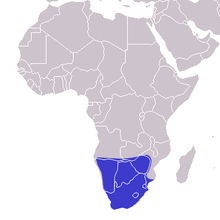Pseudaspis cana
| Mole snake | |
|---|---|
 |
|
| Scientific classification | |
| Kingdom: | Animalia |
| Phylum: | Chordata |
| Class: | Reptilia |
| Order: | Squamata |
| Suborder: | Serpentes |
| Family: | Colubridae |
| Genus: | Pseudaspis |
| Species: | P. cana |
| Binomial name | |
|
Pseudaspis cana (Linnaeus, 1758) |
|
 |
|
|
Distribution of the Mole snake
|
|
The mole snake (Pseudaspis cana) is a species of snake in the family Colubridae. It is native to much of southern Africa, and is the only member of the genus Pseudaspis. A study showed that P. cana is caught and consumed by the honey badger, among other species. Remains of the mole snake were found in the faeces, and suggest the consumed individuals were larger specimens.
P. cana was originally described by Linnaeus in 1758. Its original binomial name was Coluber cana. Since then, it has also been known as Coronella cana (Duméril, Bibron, & Duméril, 1854), before being reclassified as Pseudaspis cana (Boulenger, 1893).P. cana is the only species in genus Pseudaspis.
The mole snake can grow to lengths of up to 2 m (6 ft 7 in). A small head and pointed snout are said to be characteristics of the species. It has a firm, tubular body. Like the majority of the Colubridae, P. cana is not venomous.
In mature individuals, the body is mostly one colour, and may vary from yellow to brown to grey, and in some cases, solid black. The young have dark markings and spots that are gradually lost as the individual ages. Colour may be related to geography; in the south, most specimens are black, whereas specimens found in the northern part of their range are brown, reddish-brown, grey, or yellow.
The primary food source of P. cana is golden moles (hence the name), rodents, and other small mammals. For this reason, it is considered useful for the natural control of problem rodents.
Its diet may also include the eggs of seafowl. At Robben Island, mole snakes were observed eating the eggs of Spheniscus demersus (African penguin), Larus hartlaubii (Harlaub's gull), and Numida meleagris (helmeted guinea-fowl). Juveniles were observed eating Strongylopus grayii (clicking stream frogs).
...
Wikipedia
